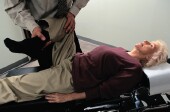- Skip Storing This Everyday Product in the Fridge Door
- Green Tea + B3 Pairing May Boost Brain Health
- Navigating Your Midlife Crisis: Embracing New Possibilities
- City Raccoons Showing Signs of Domestication
- Mapping the Exposome: Science Broadens Focus to Environmental Disease Triggers
- One Week Less on Social Media Linked to Better Mental Health
- Your Brain Changes in Stages as You Age, Study Finds
- Some Suicide Victims Show No Typical Warning Signs, Study Finds
- ByHeart Formula Faces Lawsuits After Babies Sickened With Botulism
- Switch to Vegan Diet Could Cut Your Greenhouse Gas Emissions in Half
Physical Therapy May Not Improve Hip Arthritis, Study Finds


Physical therapy for people with arthritis of the hip doesn’t help relieve pain or improve function more than receiving a sham treatment, a new study by Australian researchers suggests.
“Receiving physical therapy did not add any greater benefit over simply seeing a caring physical therapist and having positive expectations about treatment,” said lead author Kim Bennell, a research physiotherapist at the University of Melbourne.
However, other experts contend that physical therapy will benefit some patients, particularly those who are overweight and inactive.
The type of arthritis the researchers looked at is known as osteoarthritis. This is the most common form of arthritis, affecting 27 million people in the United States, according to the Arthritis Foundation. Osteoarthritis occurs when the cartilage between bones wears down, causing the bones to rub together.
Treatment guidelines recommend physical therapy. But, the study authors noted that the cost of physical therapy can be significant. They also pointed out that previous research hasn’t conclusively shown that physical therapy is effective for arthritis, according to background information in the study.
Physical therapy sessions for hip arthritis may include exercise, manual therapies — such as joint manipulation, massage and ultrasound therapy — education, instruction on home exercises, and if needed, devices to help with walking, such as a cane, according to the study.
The study, which was funded by the Australian National Health and Medical Research Council, was published in the May 21 issue of the Journal of the American Medical Association.
For the study, Bennell’s team randomly assigned 102 patients with hip osteoarthritis to 10 sessions of physical therapy plus home exercise and walking, or a sham treatment. Sham treatments included ultrasound therapy with an inactive device, and instructions on at-home use of a gel that contained no active ingredients.
For 24 weeks after treatment, people in the physical therapy group continued home exercise, while the sham group continued to apply gel three times a week.
After 13 and 36 weeks of treatment, the researchers found statistically significant improvement in pain and physical functioning for both groups. Those who had actual physical therapy fared no better than those who received the sham treatment, according to the report.
Moreover, patients in the physical therapy group reported significantly more adverse side effects, although these were relatively mild, the study authors noted.
“This is not what we predicted would happen, as we predicted that the ‘real’ physical therapy group would show greater improvements in pain and physical function than the sham group,” Bennell said.
This suggests that people can gain benefits for pain and function by simply seeing a physical therapist, according to Bennell.
The findings question the value of the specific components of physical therapy, such as exercise and manual therapy, she said.
Dr. Houman Danesh, director of integrative pain management and an assistant professor of anesthesiology at Mount Sinai Hospital in New York City, said that physical therapy does help, but it depends on what’s causing the pain.
“It depends on whether the patient has problems walking, or the wrong kind of shoes, or muscle imbalances,” he said. “If you have hip pain because the knee is out of whack, if you treat the hip, it’s not going to get better.”
Treatments for hip pain include injections of the person’s own blood platelets, which help regenerate tissue, and steroid injections. If the joint is deteriorated and the pain is very bad, a hip replacement is an option, Danesh said.
Using a cane and wearing cushioned shoes may also help with hip pain, he added.
Dr. Natalie Azar, a clinical assistant professor in the departments of medicine and rheumatology at NYU Langone Medical Center in New York City, said, “I have found that the benefit of physical therapy varies so much with each patient, as well as the state of the disease.”
Azar noted that physical therapy doesn’t usually help arthritis of the hip. Injections of steroids and painkillers are more effective, she said.
Physical therapy tends to be more useful with people who aren’t physically active or who have balance or other walking problems, she added.
For some people, physical therapy may not be recommended at all. Specifically, physical therapy could make someone with torn cartilage in the hip worse (called a hip labral tear), Azar said.
More information
For more about hip osteoarthritis, visit the American Academy of Orthopaedic Surgeons.
Source: HealthDay
Copyright © 2025 HealthDay. All rights reserved.










